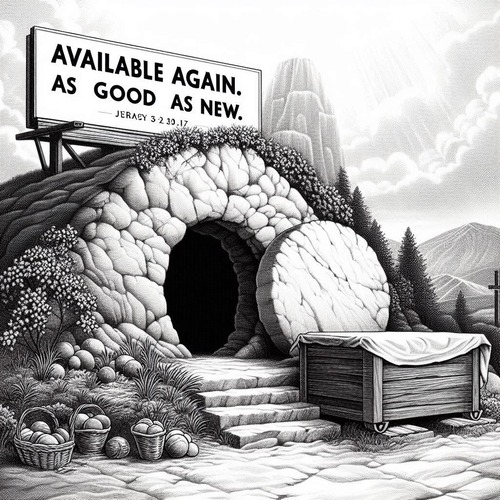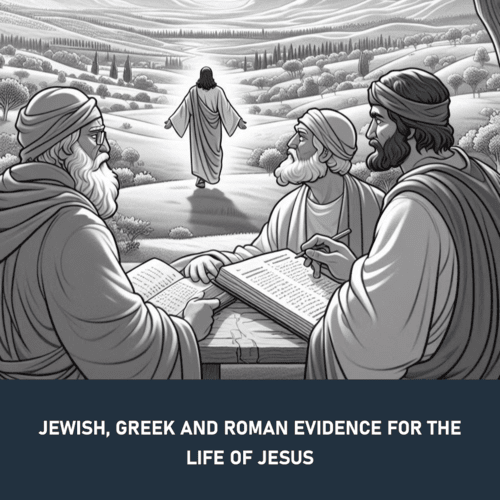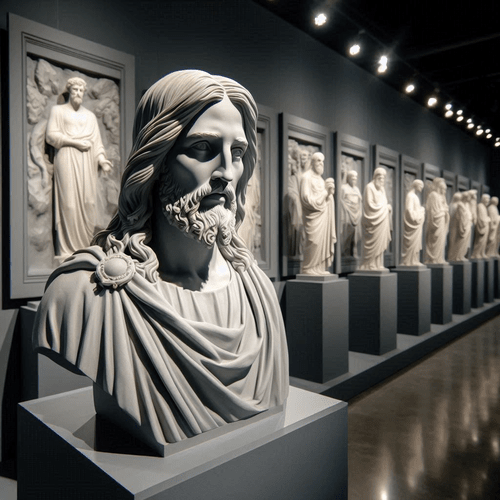Did Jesus Rise from the Dead?
Was Jesus’ resurrection a mere myth, a collective hallucination, or an empirical historical event? This earth-shattering question has captivated minds for centuries. While faith plays a role, the historical evidence is so powerful even the most sceptical investigators have found themselves compelled to acknowledge the resurrection as an indisputable event. Join us as we unpack the undeniable historical proof that Jesus defeated death.
The Inconvenient Empty Tomb: At the very heart of the resurrection account lies the undisputed historical fact that Jesus’ tomb was found inexplicably empty that Sunday morning. This wasn’t a minor detail that could be easily overlooked or dismissed—it struck a profound chord with both Christ’s followers and critics alike. If Jesus’ corpse had simply remained in the tomb, it would have been elementary for opponents to immediately and definitively abolish the resurrection rumor by merely producing the body. But they couldn’t do so—because the tomb was indisputably vacant.
What accounts for the empty tomb? The Resurrection is the best explanation. The only other plausible explanation is that Jesus’ body was stolen. But by whom? Neither the Jewish authorities nor the Roman soldiers would have any motive to steal the body, especially since Pilate’s official seal was on the tomb’s stone. That leaves Jesus’ own disciples as potential culprits. However, it seems highly unlikely they would have stolen the body: READ SECTION, ‘STOLEN BODY’, BELOW.
This empty tomb evidence thus presents an enormously inconvenient problem for Jesus’ detractors that they can never adequately explain away. All attempted naturalistic explanations for the empty tomb have fatal flaws. The resurrection best accounts for this groundbreaking historical data.
The Astonishing Transformation of Cowering Deserters: Jesus’ closest companions were simple, rootless men who scattered like cowards after His arrest. Yet just weeks after His execution, these former deserters did an astonishing about-face. Boldly proclaiming their Master’s resurrection, they began gathering masses of followers and sparked an unstoppable movement that quickly spread across the Roman empire. What dramatically transformed them—from sheepish runaways to fearless evangelists? They insisted they had encountered the risen Christ—a testimony they maintained despite imprisonment, torture, and brutal execution.
The Ultimate Evidence: Their Willing Embrace of Martyrdom: If the disciples had conspired to foist a “resurrection myth,” any one of them could have averted horrific martyrdom by simply recanting. Instead, they unhesitatingly chose cruel execution over denying their testimony about Jesus’ resurrection. People may initially embrace a lie, but under threat of torture and death? Sane people don’t willingly suffer atrociously for something they know is fiction. READ ABOUT FIVE OF THEM: THEY SAW THE RISEN LORD
Embarrassingly Early Written Sources: Historical records confirm belief in the bodily resurrection of Jesus erupted in Jerusalem and Asia Minor almost immediately after His death in 30 AD. Within 20 years, resurrection statements began appearing in written texts. The Apostle Paul’s first letter to the Corinthians in 55 AD embedded an ancient creed about Jesus’ post-resurrection appearances that originated within 5 years of his crucifixion. In that era of rampant illiteracy and oral traditions, such early written accounts suggest the authors had personally witnessed or been in close contact with eyewitnesses of the risen Christ. Deliberate legend or delusion couldn’t spawn such rapid, widespread belief so quickly.
Post-Crucifixion Appearances to Numerous Eyewitnesses: One of the most compelling evidences for the resurrection of Jesus Christ is the numerous post-crucifixion appearances to various eyewitnesses. According to the New Testament, Jesus appeared to Mary Magdalene, the apostles, and over 500 followers at once (1 Corinthians 15:6). These appearances were not fleeting glimpses but involved substantial interactions, such as conversations, shared meals, and physical contact (e.g., Thomas touching Jesus’ wounds). The consistency and frequency of these encounters provided a strong foundation for the early Christian testimony, making it difficult to dismiss the resurrection as a hallucination or fabrication. The willingness of these eyewitnesses to endure persecution and martyrdom further underscores their conviction in the reality of these appearances.
Emergence of the Church Despite Persecution: Another significant evidence of the resurrection is the rapid and widespread emergence of the Christian Church despite severe persecution. Following the resurrection, the apostles and early Christians boldly proclaimed Jesus’ resurrection, facing imprisonment, torture, and execution. The message of a risen Christ spread from Jerusalem to the far reaches of the Roman Empire, attracting a diverse following despite the risks involved. The transformation of the apostles from a group of frightened, disheartened individuals into bold evangelists is particularly striking. Their unwavering dedication and the resulting explosive growth of the Church suggest that they were driven by a profound, genuine belief in the resurrection, something they would unlikely sustain in the face of relentless opposition without compelling proof.
Change of Day of Worship to Sunday: A further evidence supporting the resurrection is the early Christian practice of worshipping on Sunday, the first day of the week. Prior to this shift, the Jewish Sabbath on Saturday was the primary day of worship. However, following the resurrection, early Christians began gathering on Sunday to commemorate Jesus rising from the dead, as reported in all four Gospels. This change is significant because it symbolizes a major theological shift from Jewish traditions, indicating the profound impact of the resurrection event. The consistent and widespread adoption of Sunday worship in the early Christian communities underscores the importance they placed on the resurrection, marking it as a cornerstone of their faith and practice.
Transformation of the Most Cynical Investigators Throughout history, innumerable sceptics set out to disprove the resurrection—only to become believers after examining the evidence. Former atheists like CS Lewis, Frank Morrison, and Lee Strobel fastidiously investigated the resurrection from archaeological, historical, and forensic angles, certain they could debunk it as a fable. Yet one by one, they became compelled to accept the overwhelming proof of this unprecedented event. Strobel stated bluntly: “After looking at the evidence, it dawned on me—I was being intellectually dishonest with myself by rejecting the resurrection of Jesus Christ. The evidence was too strong to turn away.” As for Morrison, he initially set out to write a book debunking the resurrection. However, a thorough examination of the evidence led him to a complete reversal of his views. His book, Who Moved the Stone argues for the historical reality of the resurrection.
REFUTING COMMON OBJECTIONS
- Swoon Theory: The idea that Jesus merely fainted on the cross and later revived has been proposed, but it crumbles under examination. The brutal Roman flogging, crucifixion ordeal, and the spear wound inflicted by soldiers specifically aimed to ensure death make mere unconsciousness extraordinarily improbable. It strains credulity even to consider Christ survived such trauma—leave alone to move the stone, overpower guards, and convince disciples He had conquered death.
- Stolen Body: Some assert Jesus’ disciples surreptitiously removed His corpse from the tomb. However, this fails to account for the Roman guard, the disciples’ tendency to cower rather than undertake daring raids, and why they would then sacrifice everything to promote a lie. Stealing the body would have accomplished nothing.
- Legend Development: The notion that resurrection beliefs emerged gradually as a legend or myth cannot be reconciled with the contemporaneous eyewitness accounts and early dated creeds affirming the resurrection spelled out in the New Testament texts, merely years after the events occurred. Legends take time to develop—and too little of it had elapsed.
- Mass Hallucination: It’s very unlikely the appearances of Jesus after His resurrection were just hallucinations experienced by groups of people. Hallucinations are personal experiences that differ from person to person. It’s unrealistic for many people to have exactly the same hallucination or vision, especially at different times and places. The numerous eyewitness accounts should also put to rest notions that these appearances were simply hallucinations.
- The “Lie” Theory: Some assert the disciples knowingly fabricated the resurrection story, perpetrating a deliberate lie. However, this proposed motive fails to explain several factors: Why would the disciples embrace a life of hardship, deprivation, and brutal persecution for a misleading fable? They gained nothing materially by lying. People may choose to lie to gain something, but they would not willingly endure torture, execution, and martyrdom to uphold a lie they know to be false. Moreover, if they were lying about the resurrection, it’s highly improbable they would all maintain the same falsehoods to the grave—without a single deathbed confession. For these reasons, the “lie” hypothesis lacks explanatory power.
By examining these objections in-depth, we see each naturalistic counter aimed at dismissing the resurrection runs into fundamental logical roadblocks and difficulties far exceeding the historical evidence affirming the unprecedented events.
Conclusion: A Profound Historical Reality Attempts to explain away the resurrection with theories of hallucination, body theft, or legend thus fail under scrutiny. The historical record resoundingly points one way alone: Jesus’ victory over mankind’s oldest, cruellest enemy—death. This astounding miracle stands unparalleled in human experience. Though certainly profound spiritually, the resurrection of Jesus is not just a religious belief but a reality corroborated by an overwhelming wealth of historical data. For those willing to weigh the evidences, the conclusion is inescapable—Jesus Christ did conquer the grave.
Related Reads
Editor's Pick
SUPPORT US:
Feel the Holy Spirit's gentle nudge to partner with us?
Donate Online:
Account Name: TRUTHS TO DIE FOR FOUNDATION
Account Number: 10243565459
Bank IFSC: IDFB0043391
Bank Name: IDFC FIRST BANK






